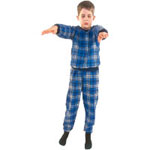Sleepwalking in Children Causes
 Sleep walking is very common in children though it occurs only occasionally and children grow out of it as they grow older. It is also called somnambulism. The behaviour exhibited by a child said to be sleep walking covers a wide range. A child may sit up while asleep and then lie down. This is pretty harmless. At other times he may start wandering in the room or go outside. The child may fall or hurt himself otherwise. Sometimes he may indulge in inappropriate behaviour like urinating on a table.
Sleep walking is very common in children though it occurs only occasionally and children grow out of it as they grow older. It is also called somnambulism. The behaviour exhibited by a child said to be sleep walking covers a wide range. A child may sit up while asleep and then lie down. This is pretty harmless. At other times he may start wandering in the room or go outside. The child may fall or hurt himself otherwise. Sometimes he may indulge in inappropriate behaviour like urinating on a table.
Children will not remember what they do though parents will get disturbed by their actions. Children will look dazed and if they are woken during sleep walking, they will be confused. Children usually sleep walk in an hour or two after falling asleep. The bout may last for as little as a few seconds or may extend up to 30 minutes.
Sleep walking occurs during deep sleep. When we go to sleep, the brain passes through five stages of sleep – 1, 2, 3, 4 and rapid eye movement sleep or REM. These stages together form one sleep cycle and a person undergoes 4 to 5 sleep cycles per night as he sleeps. Each cycle is of about 90 minute’s duration. When a person is in deep sleep of stages 3 and 4, it is then that sleep walking occurs. If a person is woken up at that time, it is difficult for him to become alert and he may become disoriented for some time.
A child may be said to be sleep walking when he talks in his sleep and it is difficult to wake him up. If you try to do so, he appears clumsy and dazed. If you talk to him, it seems that he has not heard you and will not answer. Sometimes he may sit up in bed and keep repeating a particular action.
The child’s eyes will be open but he will be unaware of his surroundings and will not register what he is seeing. He may not realise in which room or place he is. He may also wet his bed (enuresis). He may suffer from night fright and sleep apnoea, which is cessation of breathing for a few seconds.
Sleepwalking in children causes
The causes of sleep walking are many. If you or your partner sleep walked during childhood it is likely that your children may do so too. If the child is tired or not had enough sleep, or his regular sleep schedules are disturbed, it may lead to sleep walking. Stress is another factor which is responsible for this condition. Certain medicines, high fever or an illness may have a detrimental effect and lead to sleep walking. Sleep walking can only be rarely attributed to emotional or psychological problems.
How to stop sleepwalking in children?
To try to minimise sleep walking you can try these tips:
- Curtail liquids in the evening and ask the child to go to the bathroom before going to bed.
- The child should not have caffeine containing products a few hours before bed time.
- Advance the child’s bedtime by an hour or so. This way the child will get more sleep and rest.
- Fix the time of daytime nap and bed time at night and follow it. Both going to bed and waking up time should be the same every day.
- The bedroom of the child should be a quiet place where going to sleep is easy. When the child is trying to sleep keep the volume of TV and other gadgets low in other rooms.
Precautions
Precautions should be taken to keep the child safe at night so that if he sleep walks, he comes to no harm. Since he is not aware of what he is doing, he may fall down, walk out of the house or if old enough to drive, may do so.
- Lock the windows and door in the whole house or you may put child safety locks. Keys should be kept out of reach of the child.
- Keep the keys of all vehicles in a safe place where the child cannot reach them.
- Do not keep any sharp or breakable things lying around the house or in the child’s room.
- Safety gates can be installed at the top of stair cases and outside the child’s room.
- The floor of the room of the child should be clear or he may stumble over some object when sleep walking. The same goes for any other room in the house which he can access at night.
- Don’t try to wake the child if you see him sleep walking but hold his hand and lead him back to bed.